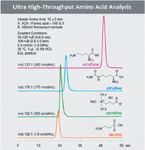Ultra-High Throughput Amino Acid Analysis in Less Than One Minute
High throughput analysis of amino acids has been a goal for both column and instrument manufacturers for many years.
High throughput analysis of amino acids has been a goal for both column and instrument manufacturers for many years. Current technologies have resulted in HPLC runtimes as low as 8 min, which is considered to be quite fast. However, when you also add the time it takes for the necessary derivatization steps, the total analysis time can be more than 15 min per sample. The solution presented here reduces this time to less than 1 min which can be achieved in a two-step process. First, use of the new Intrada Amino Acid column enables the separation of amino acids by LC–MS, without pre- or post-LC derivatization. This eliminates the need for costly reagent kits and can significantly reduce the analysis time per sample. Second, by using the available 10 mm length column, runtimes under 1 min are reliably produced.

Figure 1: High throughput analysis of related small molecules is possible using Intrada Amino Acid and detection via single quadrupole mass spectrometry.
Experimental
All data were generated using a semi-micro HPLC system equipped with ESI MS detection in positive ion mode. High throughput separations of carnitine-related compounds (Figure 1) were accomplished using an Intrada Amino Acid 10 × 2 mm column. Separation of 19 amino acids in less than 1 min was accomplished using an Intrada Amino Acid 10 × 3 mm column (Figure 2). Identical mobile phases A and B were used in both experiments, ACN:Formic Acid, and 100 mM ammonium formate, respectively. Amino acids were detected using a Shimadzu LCMS-8040 in positive ion mode.

Figure 2: Use of SIM mode detection allows for the rapid resolution of these 19 amino acids in under one min.
Discussion
Current amino acid analysis techniques take more than 15 min per sample. With the development of this unique, proprietary ligand the additional derivatization step is no longer necessary, which can potentially provide a significant cost and time savings. As seen in Figures 1 and 2, by using 10 mm length columns, further dramatic increases in time savings can be accomplished. There are some limitations with this technology particularly if chromatographic separation is necessary, as in the case of isobaric amino acids. In this case, a 50 mm column length is adequate for chromatographic resolution. If isobaric compounds are not present, there is an opportunity with the Intrada Amino Acid column for the development of ultra-high throughput amino acid analyses.

Imtakt USA
1104 NW Overton St., Portland, OR 97209
tel. (888) 456-HPLC, (215) 775-8902, fax (501) 646-3497
Website: www.imtaktusa.com

SEC-MALS of Antibody Therapeutics—A Robust Method for In-Depth Sample Characterization
June 1st 2022Monoclonal antibodies (mAbs) are effective therapeutics for cancers, auto-immune diseases, viral infections, and other diseases. Recent developments in antibody therapeutics aim to add more specific binding regions (bi- and multi-specificity) to increase their effectiveness and/or to downsize the molecule to the specific binding regions (for example, scFv or Fab fragment) to achieve better penetration of the tissue. As the molecule gets more complex, the possible high and low molecular weight (H/LMW) impurities become more complex, too. In order to accurately analyze the various species, more advanced detection than ultraviolet (UV) is required to characterize a mAb sample.















